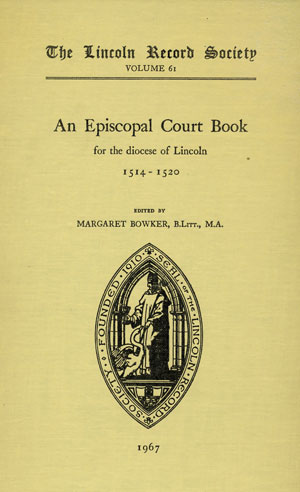
The visitation records of the diocese of Lincoln for the early part of the sixteenth century have often been quoted as they provide some useful information about the state of the church in the last two decades before the break with Rome. Lincoln Record Society volumes 33, 35 and 37, provide some evidence about the state of affairs in the parishes. Although they are an important source of evidence they have considerable limitations. These are discussed in the introduction to this volume. Diocesan Court Books take up the story where the visitations leave off. The real meaning of the visitation returns does not emerge until their sequel, contained in the court books, is studied. The proceedings recorded in this volume seem to be those of the bishop’s court of audience. This was the court held before the bishop himself or before his chancellor, vicar general or any household clerk specifically deputed by him.
Adapted from The Introduction
Adapted from The Introduction

Volume 61 An Episcopal Court Book for the Diocese of Lincoln 1514-1520
Editor Margaret Bowker, B.Litt., M.A. Fellow of Girton College, Cambridge
Date For year ending 31st August 1966
Publication Date 1967
Size 255 x 155 mm
Language Latin with some documents in English in the original sixteenth century spelling set in a modern typeface
Printer J.W. Ruddock & Sons Ltd. Lincoln
Note On the reverse of the title page: This volume has been produced with the assistance of grants from the British Academy and from Girton College, Cambridge
Content Preface, 1 page
Contents, 1 page
Notes on the Edition, 1 page
Abbreviations, 1 page
Introduction, 26 pages
The Court Book, 141 pages
Index of Persons and Places, 15 pages
Index of Subjects, 3 pages
Description The visitation records of the diocese of Lincoln for the early part of the sixteenth century have often been quoted as they provide some useful information about the state of the church in the last two decades before the break with Rome. Lincoln Record Society volumes 33, 35 and 37, provide some evidence about the state of affairs in the parishes. Although they are an important source of evidence they have considerable limitations. These are discussed in the introduction to this volume. Diocesan Court Books take up the story where the visitations leave off. The real meaning of the visitation returns does not emerge until their sequel, contained in the court books, is studied. The proceedings recorded in this volume seem to be those of the bishop’s court of audience. This was the court held before the bishop himself or before his chancellor, vicar general or any household clerk specifically deputed by him.
Adapted from The Introduction
Editor Margaret Bowker, B.Litt., M.A. Fellow of Girton College, Cambridge
Date For year ending 31st August 1966
Publication Date 1967
Size 255 x 155 mm
Language Latin with some documents in English in the original sixteenth century spelling set in a modern typeface
Printer J.W. Ruddock & Sons Ltd. Lincoln
Note On the reverse of the title page: This volume has been produced with the assistance of grants from the British Academy and from Girton College, Cambridge
Content Preface, 1 page
Contents, 1 page
Notes on the Edition, 1 page
Abbreviations, 1 page
Introduction, 26 pages
The Court Book, 141 pages
Index of Persons and Places, 15 pages
Index of Subjects, 3 pages
Description The visitation records of the diocese of Lincoln for the early part of the sixteenth century have often been quoted as they provide some useful information about the state of the church in the last two decades before the break with Rome. Lincoln Record Society volumes 33, 35 and 37, provide some evidence about the state of affairs in the parishes. Although they are an important source of evidence they have considerable limitations. These are discussed in the introduction to this volume. Diocesan Court Books take up the story where the visitations leave off. The real meaning of the visitation returns does not emerge until their sequel, contained in the court books, is studied. The proceedings recorded in this volume seem to be those of the bishop’s court of audience. This was the court held before the bishop himself or before his chancellor, vicar general or any household clerk specifically deputed by him.
Adapted from The Introduction